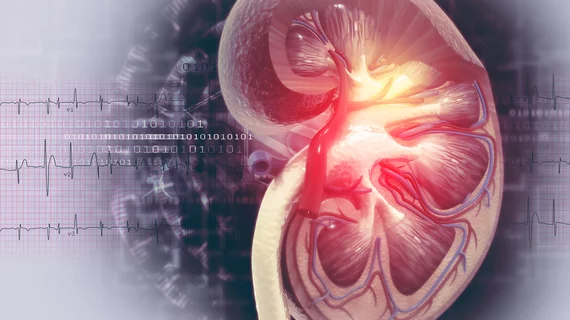Acute kidney injury after TAVR linked to certain risks, but most patients have a full recovery
Patients who develop acute kidney injury (AKI) after transcatheter aortic valve replacement (TAVR) face a heightened risk of dialysis treatment or death after one year, according to new findings published in the Journal of the American Heart Association.[1]
“TAVR is the most common treatment for severe symptomatic aortic stenosis, and as the indication of transcatheter treatment has expanded, the number of TAVR procedures is expected to increase even further,” wrote Jeppe Kofoed Petersen, MB, a researcher with the department of cardiology at Copenhagen University Hospital in Denmark, and colleagues. “While it is well established that chronic kidney disease poses a severe risk of fatal outcomes in patients receiving TAVR, the procedure‐related risk of renal impairment and the following prognostic implications are yet to be fully elucidated.”
Petersen et al. tracked data from more than 4,000 TAVR patients treated in Denmark from 2014 to 2021. Patients were excluded if they had a history of dialysis treatment or died within 21 days of the procedure.
For the sake of this study, AKI was defined as an increase in creatinine of at least 50% within seven days of undergoing TAVR.
Overall, 4.7% of patients included in the analysis presented with AKI. The median age among patients with AKI was 82 years old, and the median age among patients without AKI was 81 years old.
The research team noted that TAVR patients with AKI were more likely to require dialysis within one year of treatment than patients without AKI. All-cause death was also higher among AKI patients.
“These findings are highly pertinent in a clinical setting and merely underline that even small changes in creatinine levels may have significant implications on the sustained decline of kidney function and overall prognosis,” the authors wrote. “Additionally, our results underscore the importance of timely initiation of renal replacement therapy during the postprocedural phase to prevent long‐term kidney deterioration and possible need for chronic renal replacement therapy.”
One key takeaway from this analysis was that was 74% of the AKI patients had a full recovery within six months. However, at that same six-month endpoint, 14.7% of patients had an “incomplete” recovery, 6.3% did not recover at all and 5.1% were actively undergoing dialysis treatment.
The authors did highlight certain limitations with their work. For example, it was an observational study, so causality could not actually be established. Also, certain patient details—such as the specific TAVR valve used for each procedure—were not available
Read the full study here.

